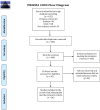Tantalum Versus Titanium Acetabular Cups in Primary Total Hip Arthroplasty: Current Concept and a Review of the Current Literature
- PMID: 35755796
- PMCID: PMC9194707
- DOI: 10.22038/ABJS.2021.55255.2750
Tantalum Versus Titanium Acetabular Cups in Primary Total Hip Arthroplasty: Current Concept and a Review of the Current Literature
Abstract
Background: Primary total hip arthroplasty (THA) is becoming an increasingly popular and efficacious medical procedure. There have been a number of studies evaluating tantalum acetabular cups compared with the conventional titanium acetabular cups for use in total hip arthroplasties. We conducted a systematic review and summarize clinical studies comparing tantalum acetabular cups with the conventional titanium acetabular cups for use in primary total hip arthroplasties.
Methods: A literature search was performed to find all relevant clinical studies until March 2020, which then underwent a further selection criteria. The inclusion criteria was set as follows: Reporting on human patients undergoing primary total hip arthroplasty; Direct comparison between tantalum acetabular cups with conventional titanium acetabular cups for use in primary total hip arthroplasty; Radiological evaluation (cup migration, osteointegration); Clinical (functional scores, need for subsequent revision, patient-reported outcomes; Post-operative complications; Reporting findings in the English Language. After a thorough search a total of six studies were included in the review. The primary outcome measures were clinical outcomes, implant migration, change in bone mineral density and rate of revision and infection.
Results: Tantalum is superior to titanium with regards to fewer radiolucencies, 100% survivorship at 12 years post-operatively, improved long-term implant osteointegration and survivorship as well as decreasing osteolysis and mechanical loosening. There has been no significant difference in radioisometric analysis, bone mineral density or Harris Hip Score. Revision and infection rates were found to be significantly lower in tantalum group at 10 years from pooled data of national joint registry (England and Wales), while it was found to be higher in the same at 9 years from pooled data of Swedish and Australian registry although this is not statistically significant.
Conclusion: The use of tantalum should be reserved for cases of high risk of failure or mechanical loosening, where failure of a contralateral joint occurred. The use of Tantalum carries lower risk of failure and infection. Further studies with longer follow-up would be useful in drawing further conclusions.
Keywords: Acetabular cup; Primary total hip arthroplasty; Tantalum; Titanium.
Figures
References
-
- Liang MH, Cullen KE, Larson MG, Thompson MS, Schwartz JA, Fossel AH, et al. Cost-effectiveness of total joint arthroplasty in osteoarthritis. Arthritis Rheum. 1986 Aug;29(8):937–43. - PubMed
-
- Jonsson B, Larsson SE. Functional improvement and costs of hip and knee arthroplasty in destructive rheumatoid arthritis. Scand J Rheumatol. 1991;20(5):351–7. - PubMed
-
- Kurtz S, Ong K, Lau E, Mowat F, Halpern M. Projections of primary and revision hip and knee arthroplasty in the United States from 2005 to 2030. J Bone Joint Surg Am. 2007 Apr;89(4):780–5. - PubMed
-
- Della Valle CJ, Mesko NW, Quigley L, Rosenberg AG, Jacobs JJ, Galante JO. Primary total hip arthroplasty with a porous-coated acetabular component A concise follow-up, at a minimum of twenty years, of previous reports. J Bone Joint Surg Am. 2009 May;91(5):1130–5. - PubMed
-
- Engh CA, Hopper RH, Engh CA. Long-term porous-coated cup survivorship using spikes, screws, and press-fitting for initial fixation. J Arthroplasty. 2004 Oct;19(7 Suppl 2):54–60. - PubMed
Publication types
LinkOut - more resources
Full Text Sources


